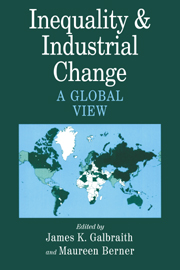Book contents
- Frontmatter
- Contents
- Contributors
- Permissions
- Acknowledgments
- PART I INTRODUCTION TO THEORY AND METHOD
- PART II INEQUALITY, UNEMPLOYMENT, AND INDUSTRIAL CHANGE
- PART III INEQUALITY AND DEVELOPMENT
- PART IV METHODS AND TECHNIQUES
- 15 Constructing Long, Dense Time Series of Inequality Using the Theil Index
- 16 Cluster and Discriminant Analysis of Time Series as a Research Tool
- Data Appendix
- References and Selected Bibliography
- Index
15 - Constructing Long, Dense Time Series of Inequality Using the Theil Index
Published online by Cambridge University Press: 05 June 2012
- Frontmatter
- Contents
- Contributors
- Permissions
- Acknowledgments
- PART I INTRODUCTION TO THEORY AND METHOD
- PART II INEQUALITY, UNEMPLOYMENT, AND INDUSTRIAL CHANGE
- PART III INEQUALITY AND DEVELOPMENT
- PART IV METHODS AND TECHNIQUES
- 15 Constructing Long, Dense Time Series of Inequality Using the Theil Index
- 16 Cluster and Discriminant Analysis of Time Series as a Research Tool
- Data Appendix
- References and Selected Bibliography
- Index
Summary
Wage and earnings data by industrial sectors are readily available for many countries over long time frames. This chapter explores the application of the between-group component of the Theil index to data on wages, earnings, and employment by industrial classification in order to measure the evolution of wage or earnings inequality through time. We provide formal criteria under which such a between-group Theil statistic can reasonably be assumed to give results that also track the (unobserved) evolution of inequality within industries. While the evolution of inequality in manufacturing earnings cannot be taken as indicating per se the larger movements of inequality in household incomes, including those outside the manufacturing sector, we argue on theoretical grounds that the two will rarely move in opposite directions. We conclude with an empirical application to the case of Brazil.
Introduction
Most empirical work on inequality uses measures that are based on household surveys. These measures aim to provide a comprehensive overview of income inequalities, covering all social strata and comparable both through time and between countries. The Gini coefficient is the index most commonly computed from these sources, though various quintile ratios are also frequently deployed. But, as Galbraith and Lu have discussed (see Chapter 8), there are many gaps as well as other deficiencies in this data.
Fortunately, the decomposability properties of the Theil measure make it possible to repair this gap in part, albeit in most cases only for the limited span of the manufacturing economy.
- Type
- Chapter
- Information
- Inequality and Industrial ChangeA Global View, pp. 263 - 279Publisher: Cambridge University PressPrint publication year: 2001
- 4
- Cited by



